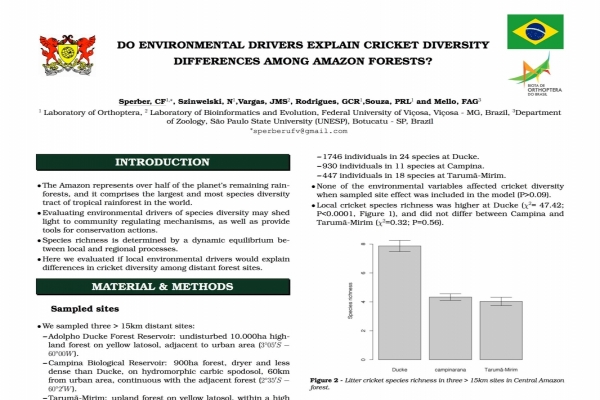Painéis
Do environmental drivers explain cricket diversity differences among Amazon forests?
Amazon forest litter cricket diversity decreases with litter weight and increases with fungi presence. Here we evaluated if these local environmental drivers would explain differences in cricket diversity among distant forest areas. We sampled three > 15km distant areas: Adolpho Ducke Forest Reservoir (undisturbed 10.000ha upland forest on yellow latosol, adjacent to urban area, 3º05'S 60º00'W), Campina Biological Reservoir (900ha campinarana forest, on hydromorphic carbic spodosol, 60km from urban area, continuous with the adjacent forest, 2º35’S 60º2’W) and Tarumã-Mirim (upland forest on yellow latosol, within a high forest clearance intensity region, due to real estate speculation, 2º53’S 60º5W). While upland forests (Ducke and Tarumã-Mirim) are characterized by up to 25-35m height trees, in the campinarana trees are lower (10-20m) and more scattered, with higher light intensity in the underwoods. In each area we set up 30 transects of five unbaited pitfall traps (n=90), at least 30m apart from each other, partially filled with ethanol fuel, at least 30m apart from each other, and let them in the field for 48h. We measured 12 environmental variables, including resource availability, abiotic conditions, habitat heterogeneity and predation risk estimates, at each pitfall trap site, to evaluate if their effect on local species richness explained the differences among Amazon forest areas. We used a frequentist statistical approach, adjusting generalized linear models with Poisson errors, corrected for overdispersion when necessary, with number of species per transect as response variable. We evaluated the significance of explanatory terms by comparing nested models. We first adjusted separate models for each major environmental variable group: resource availability, abiotic conditions, habitat heterogeneity and predation risk. The environmental variables which presented significant effects on diversity in their group, were, then, included in a full model, which also included the three sampled areas, as categorical explanatory variable, and all interaction terms of area and environmental variables (ANCOVA). We captured a total of 3123 individuals, of which 1851 were assigned to 30 cricket species, all of them new to science: 1746 individuals in 24 species at Ducke, 930 individuals in 11 species at Campina and 447 individuals in 18 species at Tarumã-Mirim. None of the environmental variables affected cricket diversity when sampled area effect was included in the model (P>0.09). Local cricket species richness was higher at Ducke (Chi-squared= 47.42; P<0.0001, Figure 1), and did not differ between campinarana and Tarumã-Mirim (Chi=0.32; P=0.56). None of the measured environmental variables explained the differences between forest areas. This shows that, although there are local environmental drivers of cricket diversity, they do not explain differences among the sampled areas. Although the soil and forest characteristics of Ducke and Tarumã-Mirim are similar, cricket diversity of Tarumã-Mirim was similar to the lower diversity campinarana. At the campinarana forest the low cricket diversity, compared to Ducke, would be expected, due to it’s lower productivity forest. At Tarumã-Mirim, however, we would expected a similar cricket diversity as at Ducke, as far as these forests share soil and physiognomy characteristics. Tarumã-Mirim’s cricket diversity was, however, similar to campinarana. We suggest that the low diversity found at Tarumã-Mirim was promoted by the intense human activity in the region. An evidence supporting this explanation is the strikingly low cricket abundance in Tarumã-Mirim: an average of 25 individuals per cricket species, while campinarana has 85 and Ducke 73. Human disturbance is probably causing a local extinction debt, i.e. a high probability of local extinction of the cricket species that are still living in that region. These extinctions are probably being delayed by immigration from nearby forested areas. These rescue effect is doomed to be progressively reduced, along the increase of deforestation and human disturbances. We conclude that to explain regional diversity differences, it is necessary to consider disturbance regimes and forest characteristics as productivity and soil.
SPERBER, C. F.; SZINWELSKI, N.; YOTOKO, K. S. C.; MELLO, F. A. G. Do environmental drivers explain cricket diversity differences among Amazon forests?. In.: 11th International Congress of Orhopterology, Kunming – China, 2013.
Palavras-chaves: resource availability, abiotic conditions, habitat heterogeneity, predation risk estimates


